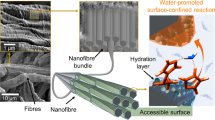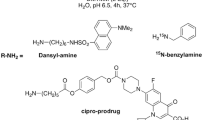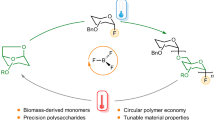Abstract
Cellulosic bottlebrushes with polystyrene (PS) and poly(ethylene glycol) (PEG) side chains at the O-6 and O-2,3 positions, respectively (PEG-PS-cellulose), were synthesized and characterized in diluted solution to reveal the second structure of heterografted bottlebrushes. The regioselectivity and degree of substitution were evaluated by 1H- and 13C-nuclear magnetic resonance spectroscopy and size-exclusion chromatography (SEC). The cross-sectional structure of PEG-PS-cellulose was evaluated from the cross-sectional radius of gyration determined by the small angle X-ray scattering technique as a function of the molecular weight of the PS side chain. As a result, PEG-PS-cellulose was found to show a core-shell-corona structure, in which PEG and PS side chains formed a homogeneous shell layer surrounding the cellulosic core and the outer segments of PS chains formed an outer corona layer. The stiffness parameter (λ−1) of the main chain was analyzed by the SEC–multiangle light scattering technique along with the Kratky-Porod wormlike chain model. In comparison with a previously reported cellulosic bottlebrush with a PS side chain at the O-6 position, it is suggested that the observed increase in λ−1 with increasing molecular weight of PS is mainly derived from the interaction among PS side chains located in an outer layer, while the PEG side chains at the O-2,3 position effectively suppressed the internal rotation of the cellulosic main chain.
This is a preview of subscription content, access via your institution
Access options
Subscribe to this journal
Receive 12 print issues and online access
$259.00 per year
only $21.58 per issue
Buy this article
- Purchase on Springer Link
- Instant access to full article PDF
Prices may be subject to local taxes which are calculated during checkout







Similar content being viewed by others
References
Xie G, Martinez MR, Olszewski M, Sheiko SS, Matyjaszewski K. Molecular bottlebrushes as novel materials. Biomacromolecules 2019;20:27–54.
Tsukahara Y, Miyata M, Senoo K, Yoshimoto N, Kaeriyama K. Mesomorphic phase formation of poly (macromonomer)s of polystyrene macromonomers. Polym Adv Technol. 2000;11:210–8.
Daniel WF, Burdynska J, Vatankhah-Varnoosfaderani M, et al. Solvent-free, supersoft and superelastic bottlebrush melts and networks. Nat Mater. 2016;15:183–9.
Altay E, Nykypanchuk D, Rzayev J. Mesoporous polymer frameworks from end-reactive bottlebrush copolymers. ACS Nano. 2017;11:8207–14.
Liu X. Surface forces between bottlebrush polymer layers. Curr Opin Colloid Interface Sci. 2020;47:16–26.
Tu S, Choudhury CK, Luzinov I, Kuksenok O. Recent advances towards applications of molecular bottlebrushes and their conjugates. Curr Opin Solid State Mater Sci. 2019;23:50–61.
Kinose Y, Sakakibara K, Sato O, Tsujii Y. Near-zero azimuthal anchoring of liquid crystals assisted by viscoelastic bottlebrush polymers. ACS Appl Polym Mater. 2021;3:2618–25.
Yoshikawa C, Sakakibara K, Nonsuwan P, Yamazaki T, Tsujii Y. Nonbiofouling coatings using bottlebrushes with concentrated polymer brush architecture. Biomacromolecules 2021;22:2505–14.
Chen K, Hu X, Zhu N, Guo K. Design, synthesis, and self-assembly of janus bottlebrush polymers. Macromol Rapid Commun. 2020;41:2000357.
Le AN, Liang R, Zhong M. Synthesis and self-assembly of mixed-graft block copolymers. Chemistry. 2019;25:8177–89.
Xie G, Krys P, Tilton RD, Matyjaszewski K. Heterografted molecular brushes as stabilizers for water-in-oil emulsions. Macromolecules 2017;50:2942–50.
Li Y, Zou J, Das BP, Tsianou M, Cheng C. Well-defined amphiphilic double-brush copolymers and their performance as emulsion surfactants. Macromolecules 2012;45:4623–9.
Palacios-Hernandez T, Luo H, Garcia EA, Pacheco LA, Herrera-Alonso M. Nanoparticles from amphiphilic heterografted macromolecular brushes with short backbones. Macromolecules 2018;51:2831–7.
Chang HY, Lin YL, Sheng YJ, Tsao HK. Multilayered polymersome formed by amphiphilic asymmetric macromolecular brushes. Macromolecules 2012;45:4778–89.
Nam J, Kim Y, Kim JG, Seo M. Self-assembly of monolayer vesicles via backbone-shiftable synthesis of janus core–shell bottlebrush polymer. Macromolecules 2019;52:9484–94.
Guo ZH, Le AN, Feng X, et al. Janus graft block copolymers: design of a polymer architecture for independently tuned nanostructures and polymer properties. Angew Chem, Int Ed. 2018;57:8493–7.
Kawamoto K, Zhong M, Gadelrab KR, et al. Graft-through synthesis and assembly of janus bottlebrush polymers from A-Branch-B diblock macromonomers. J Am Chem Soc. 2016;138:11501–4.
Stepanyan R, Subbotin A, ten Brinke G. Comb copolymer brush with chemically different side chains. Macromolecules 2002;35:5640–8.
Hsu H-P, Paul W, Binder K. Intramolecular phase separation of copolymer “bottle brushes”: no sharp phase transition but a tunable length scale. Europhys Lett. 2006;76:526–32.
Theodorakis PE, Paul W, Binder K. Analysis of the cluster formation in two-component cylindrical bottle-brush polymers under poor solvent conditions: a simulation study. Eur Phys J E: Soft Matter Biol Phys. 2011;34:52.
de Jong J, ten Brinke G. Conformational aspects and intramolecular phase separation of alternating copolymacromonomers: a computer simulation study. Macromol Theory Simul. 2004;13:318–27.
Kinose Y, Sakakibara K, Ogawa H, Tsujii Y. Main-chain stiffness of cellulosic bottlebrushes with polystyrene side chains introduced regioselectively at the O-6 position. Macromolecules 2019;52:8733–40.
Sakakibara K, Ishida H, Kinose Y, Tsujii Y. Regioselective synthesis of cellulosic janus bottlebrushes with polystyrene and poly (ε-caprolactone) side chains and their solid-state microphase separation. Cellulose 2021;28:6857–68.
Sheiko SS, Borisov OV, Prokhorova SA, Moller M. Cylindrical molecular brushes under poor solvent conditions: microscopic observation and scaling analysis. Eur Phys J E. 2004;13:125–31.
Grulke EA. Solubility Parameter Values. In: Brandrup J, Immergut EH, Grulke EA, editors. Polymer Handbook. 4th ed. New York: Wiley; 1999:VI-675–VI-714.
Sakakibara K, Kinose Y, Tsujii Y. Synthesis of Cellulosic Bottlebrushes with Regioselectively Substituted Side Chains and Their Self-assembly. In: Rosenau T, Potthast A, Hell J. editors. Cellulose Science and Technology: Chemistry, Analysis, and Applications. New York: Wiley; 2019:49–65.
Glatter O, Kratky O. Small Angle X-ray Scattering. London: Academic Press; 1982.
Benoit H, Doty P. Light scattering from non-gaussian chains. J Phys Chem. 1953;57:958–63.
Benoit H, Froelich D Application of Light Scattering to Copolymers. In: Huglin MB, editor. Huglin MB, trans. Light Scattering from Polymer Solutions. London and New York: Academic Press; 1972:467–501.
Gömez JAC, Erler UW, Klemm DO. 4-methoxy substituted trityl groups in 6-O protection of cellulose: homogeneous synthesis, characterization, detritylation. Macromol Chem Phys. 1996;197:953–64.
Yue Z, Cowie JMG. Preparation and chiroptical properties of a regioselectively substituted cellulose ether with PEO Side Chains. Macromolecules 2002;35:6572–7.
Matyjaszewski K, Nakagawa Y, Gaynor SG. Synthesis of well-defined azido and amino end-functionalized polystyrene by atom transfer radical polymerization. Macromol Rapid Commun. 1997;18:1057–66.
Wataoka I, Kobayashi K, Kajiwara K. Effect of the carbohydrate side-chain on the conformation of a glycoconjugate polystyrene in aqueous solution. Carbohydr Res. 2005;340:989–95.
Walther A, Drechsler M, Rosenfeldt S, et al. Self-assembly of janus cylinders into hierarchical superstructures. J Am Chem Soc. 2009;131:4720–8.
Yamakawa H, Yoshizaki T. Helical wormlike chains in polymer solutions. 2nd ed. Berlin: Springer, Berlin Heidelberg; 2016.
Sugiyama J, Vuong R, Chanzy H. Electron diffraction study on the two crystalline phases occurring in native cellulose from an algal cell wall. Macromolecules 1991;24:4168–75.
Nakamura Y, Norisuye T. Backbone stiffness of comb-branched polymers. Polym J. 2001;33:874–8.
Acknowledgements
High-resolution 600 MHz and 800 MHz NMR spectra were acquired with an NMR spectrometer in the Joint Usage/Research Center (JURC) at the Institute for Chemical Research, Kyoto University. Synchrotron SAXS experiments were performed at BL40B2 (Proposal Nos. 2016B1208 and 2017B1727) in SPring-8 with the approval of the Japan Synchrotron Radiation Research Institute (JASRI). The authors thank Dr. Noboru Ohta (JASRI/SPring-8) for assistance with the experiments carried out using the BL40B2 beamline.
Funding
This work was supported by a Grant-in-Aid for Challenging Exploratory Research (No. 25620175) and a Grant-in-Aid for Young Scientists (B) (No. 16K17914) from the Ministry of Education, Culture, Sports, and Technology (MEXT) in Japan.
Author information
Authors and Affiliations
Contributions
The manuscript was written through contributions of all authors. All authors have given approval to the final version of the manuscript.
Corresponding author
Ethics declarations
Conflict of interest
The authors declare no competing interests.
Additional information
Publisher’s note Springer Nature remains neutral with regard to jurisdictional claims in published maps and institutional affiliations.
Supplementary information
Rights and permissions
About this article
Cite this article
Kinose, Y., Sakakibara, K. & Tsujii, Y. Conformational characteristics of regioselectively PEG/PS-grafted cellulosic bottlebrushes in solution: cross-sectional structure and main-chain stiffness. Polym J 54, 503–513 (2022). https://doi.org/10.1038/s41428-021-00594-9
Received:
Revised:
Accepted:
Published:
Issue Date:
DOI: https://doi.org/10.1038/s41428-021-00594-9
This article is cited by
-
Special issue: Fundamentals and applications of carbohydrate polymers
Polymer Journal (2022)



